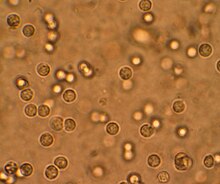Pyuria
| Pyuria | |
|---|---|
 | |
| White blood cells seen under a microscope from a urine sample. | |
| Pronunciation | |
| Specialty | Urology |
Pyuria is the condition of
Sterile pyuria
Leukocyturia
Under normal conditions, fewer than two million leukocytes are expelled in urine per day. A number greater than two million is called leucocyturia and can be determined when determining the Addis count.[3]
However, this method requires a 24-hour urine collection, so it is not practical. Currently, the number of leukocytes is estimated under the microscope for which morning urine is taken. It has been arbitrarily assumed that a number of over 4-5 leukocytes in the field of vision of the microscope indicates leukocyturia.[4]
At the moment, there are also quick test strips available, allowing after wetting a special diagnostic bar, the detection of granulocytes in the urine, as evidenced by the color change of the test strip.[5] The principle of their operation is based on the detection of granulocytes esterases, including leukocytes. This method, however, is burdened with a large number of false positive results (use of antibiotics, such as imipenem, meropenem, clavulanic acid, which is sometimes combined with penicillin derivatives) or false negative (gentamicin, cefalexin, glycosuria, proteinuria).[citation needed]
Leukocyturia is a laboratory symptom of many diseases like glomerulonephritis or pyelonephritis. It may occur in the case of diseases of the urinary tract, reproductive system and diseases of the abdominal organs.[6] Leukocyturia is mostly a sign of urinary tract infection, especially if significant bacteriuria is found (for most people, the number of bacteria in a culture is > 10^5) and other symptoms associated with passing urine.[7] The presence of leukocyturia does not indicate the need for antimicrobial therapy yet.[citation needed]
Additional images
See also
References
- PMID 25760357.
- ^ S2CID 11629600.
- ISBN 9788125012665.
- ISBN 9788131223710.
- ISBN 9783110455083.
- ^ Von Forstner, Manfred Schmidl (1986). Laboratory testing in veterinary medicine diagnosis and clinical monitoring. Boehringer Mannheim. p. 20.
- ^ Archives of Medical Research, Volume 31. Instituto Mexicano del Seguro Social. 2000. p. 214.
